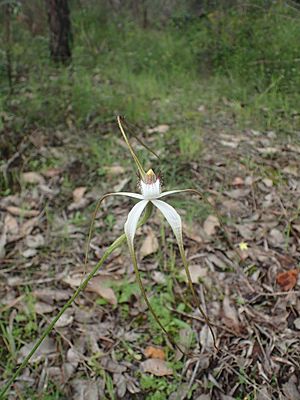Merritt's white spider orchid facts for kids
Quick facts for kids Merritt's white spider orchid |
|
|---|---|
 |
|
| Caladenia longicauda subsp. merrittii near the Blackwood River | |
| Scientific classification |
|
| Kingdom: | Plantae |
| Clade: | Tracheophytes |
| Clade: | Angiosperms |
| Clade: | Monocots |
| Order: | Asparagales |
| Family: | Orchidaceae |
| Subfamily: | Orchidoideae |
| Tribe: | Diurideae |
| Genus: | Caladenia |
| Species: | |
| Subspecies: |
C. l. subsp. merrittii
|
| Trinomial name | |
| Caladenia longicauda subsp. merrittii Hopper & A.P.Br.
|
|
| Synonyms | |
|
Arachnorchis longicauda subsp.merrittii (Hopper & A.P.Br.) D.L.Jones & M.A.Clem. |
|
Caladenia longicauda subsp. merrittii, also known as Merritt's white spider orchid, is a unique plant in the orchid family. It grows only in the south-west part of Western Australia. This orchid has a single hairy leaf and can have up to three large, mostly white flowers. These flowers are special because they have very long, drooping parts called sepals and petals. The middle part of the flower, called the labellum, is white and wide with short teeth. It is one of the biggest spider orchids you can find!
Description
Merritt's white spider orchid is a ground-growing plant. It is a perennial herb, meaning it lives for many years. It also loses its leaves during certain seasons, which makes it deciduous. This orchid grows from a tuber (like a small potato) hidden underground.
Each plant has one hairy leaf that is about 12 to 20 centimeters (5 to 8 inches) long and 0.6 to 1 centimeter (0.2 to 0.4 inches) wide.
The orchid can have up to three flowers on a tall stem, which is about 30 to 45 centimeters (12 to 18 inches) high. Each flower is mostly white and quite large, measuring about 18 to 25 centimeters (7 to 10 inches) long and 12 to 18 centimeters (5 to 7 inches) wide.
The top part of the flower, called the dorsal sepal, stands straight up. The dorsal and lateral sepals are very long, about 9.4 to 15 centimeters (4 to 6 inches) long, and they have long, drooping tips. The petals are also long, about 9 to 11 centimeters (4 to 4.3 inches) long.
The special lip-like part in the middle of the flower is called the labellum. It is white, about 2 to 2.8 centimeters (0.8 to 1.1 inches) long, and 0.9 to 1.1 centimeters (0.35 to 0.43 inches) wide. It has narrow teeth along its edges. In the center of the labellum, there are four or more rows of pale red bumps called calli. This orchid usually blooms from September to October.
Taxonomy and Naming
The way plants are named and grouped is called taxonomy. Caladenia longicauda was first officially described by John Lindley in 1840. This description was published in a book called A Sketch of the Vegetation of the Swan River Colony.
Later, in 2001, two scientists named Stephen Hopper and Andrew Brown described eleven different types, or subspecies, of Caladenia longicauda. One of these was subspecies merrittii. Their descriptions were published in a scientific journal called Nuytsia.
The subspecies was named merrittii to honor an orchid enthusiast named Wayne Merritt. He was one of the first people to realize that this orchid was a new and special type.
Distribution and Habitat
Merritt's white spider orchid mostly grows in a specific area of Western Australia. You can find it between the towns of Augusta, Margaret River, and Nannup.
It lives in jarrah forests. These forests are part of the Jarrah Forest and Warren biogeographic regions.
Conservation
The Western Australian Government's Department of Parks and Wildlife keeps track of plants and animals. They have classified Caladenia longicauda subsp. merrittii as "not threatened." This means it is not currently at risk of disappearing.

